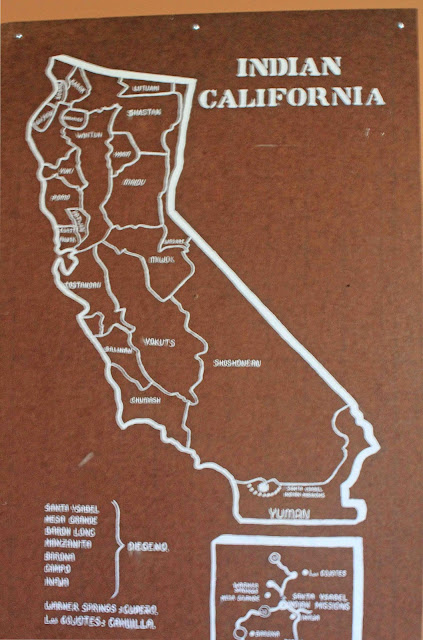While RV camping at William Heise County Park in Julian earlier this year, we made an 11-mile side trip to Santa Ysabel to check out this outpost of the California Mission chain. Established in 1818, Mission Santa Ysabel was a sub-mission or extension of Mission San Diego Alcala. Dedicated in 1924, the current church is not original, but is situated near the site of the original building. The Asistencia, located just off State Hwy. 79, consists of the church (St. John the Baptist Catholic Church), a couple side buildings (including the Indian museum), a gift shop (not open when we were there), and cemetery. Overall, a very peaceful and quiet location with few visitors. And, oh yes - it was quite hot, but luckily we were able to park under the shade of a tree in the small parking lot.

Admission Fees: None.
*****************************************************************
Cemetery. Not luvin' the chain link fence, but it must be there for a reason...
Sasha at the window of the RV.

California Registered Historical Landmark No. 369.
Interior of the church.
Beautiful stained glass inside the church.
Shady seating area in the garden across the parking lot in front of the church.
Agaves and succulents growing outside the museum building.
Swallows nest in the eaves.
Agaves, cacti and succulents outside the museum building.
Indian Museum.
Statue of the "Angel of the Lost Bells." Two of the mission bells, dating from 1723 and 1767,
went missing in 1926. This sculpture stands at the site of the missing bells.
Cacti and Rock roses.
Grave of Rev. Edmond La Pointe in front of the Indian Museum.
Well, okay then!
The museum is not manned, so you have to turn on the lights
when you go in, and then turn them off when you exit.
Indian Museum.
Indian Museum.
Indian Museum.
Indian Museum.
Indian Museum.
Indian Museum.
Indian Museum.
Indian Museum.
Indian Museum.
Indian Museum.
Indian Museum.
Indian Museum.
Looks like Cleveland Sage (Salvia clevelandii) in the garden next to the church.
Cliff Swallow nesting under the eaves of the roof.
Nesting cliff swallows.
Nesting cliff swallow.
Nesting cliff swallow.
Cemetery with view of grazing cattle in the distance.
Driveway to the church.
Picnic area off the parking lot.
Location: 23013 CA 79, Santa Ysabel, CA
http://www.californiamissionguide.com/california-mission-guide/california-mission-asistencias/
Hours: Open winter 8am to 4pm. Memorial Day to Labor Day 8am to 5:30pm.
Hours: Open winter 8am to 4pm. Memorial Day to Labor Day 8am to 5:30pm.
Admission Fees: None.
*****************************************************************
HISTORY:
The following historical info is quoted from the Mission Tour website:
20 September 1818: Padre Fernando Martin blessed the spot for a capilla at Canada de Santa Ysabel. A temporary structure was then erected.
2 February 1819: Padre Vicente Sarria noted the presence of “a goodly number of baptized souls” and asked for permission to erect a permanent church.
1822: With permission granted, a church was erected and by this year a thriving community had been established.
1836: A report indicated that erosion has started to eat away at the foundations of several buildings, including the chapel.
7 May 1839: A report indicated thriving fields, two vineyards, an orchard, and animal stock. However, the erosion reported in 1836 continued.
1846: Erosion had so eaten away at the various buildings that the chapel was in ruins and all of the mud houses had effectively dissolved. A brush ramada served as a church whenever a visiting padre made their way back into the area. Two bells, bought by the Indians for six burro loads of barley hung in a frame as the only remains of the original chapel. The bells were among the oldest in California, dating from 1723 and 1767. (The picture here is an edited version of a picture from the museum.)
1899: A report from the period indicated that only the outlines of the church remained. Everything else had “sunk into indistinguishable heaps of earth.”
1924: The current building was dedicated as Saint John the Baptist Catholic Church.
1926: The original two bells from the chapel disappeared. A day later Jose Maria Osuna found the clappers (but kept them).
1959: The clappers to the bells were returned to the Chapel and are now in the museum. A statue of the “Angel of the Lost Bells” stands at the site now.
1963: The University of California discovered the site of the original buildings, then only “faintly visible under the pasture grass.”
Father Fernando Martin celebrated the first Mass on Sept. 20, 1818 at a site nearby, an outpost of Mission San Diego. By 1822 Santa Ysabel had a chapel, cemetery, granary, many houses, and 450 neophytes. After secularization in the 1830’s, priestly visits were rare. Tradition asserts that services have been held here since 1818, under ramadas erected against one wall after the roof caved in. The present chapel was built in 1924.


























































No comments:
Post a Comment